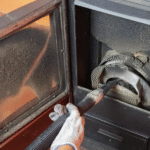Inroduction
If your home has a chimney, you might not think about what’s going on inside it—especially something hidden like a chimney liner. But that liner plays a huge role in how safely and efficiently your fireplace or furnace works. When something goes wrong with it, it’s not always obvious at first, but the effects can be serious. I’ve spent years around chimneys, and I’ve seen firsthand what happens when liners go unchecked. So let’s walk through the common problems homeowners in Colorado Springs face with their Chimney Liner and what you can do about them.
1. Cracks, Holes, and Gaps: The Silent Damage
One of the sneakiest issues with chimney liners is cracking. Over time, liners—especially clay or older metal ones—start to wear down. Chimneys go through a lot: fire, smoke, moisture, and big temperature swings. All of that stress causes the liner to expand and contract, and eventually, tiny cracks can form. At first, they don’t look like much, but smoke, gas, and heat can start slipping through those gaps instead of going up and out like they’re supposed to.
In homes where people burn wood, this problem is even more common. Creosote (the sticky black stuff that builds up from burning wood) settles into those cracks, dries out, and becomes a serious fire hazard.
Pro tip: If you ever hear strange popping or cracking sounds when using your fireplace, or smell something smoky even when it’s not lit, that’s a red flag. Time to get the liner inspected.
2. Corrosion and Rust: Metal Liners Aren’t Invincible
Stainless steel liners are popular for good reason—they’re durable, flexible, and easier to install in chimneys with odd shapes. But even the best metal liner isn’t totally immune to problems. Moisture is the main culprit here. When water mixes with the soot or combustion gases, it creates acids that eat away at the metal over time. You won’t usually see this happening unless you’re having your chimney cleaned or inspected regularly.
Rust is the visible sign, and it can weaken the structure of the liner. In serious cases, large sections of the liner may corrode completely. That’s a big safety concern, especially if your chimney is connected to a gas furnace or water heater. A compromised liner can allow carbon monoxide to leak into your home without setting off your smoke alarms.
Key Features Table of Chimney Liner Problems:
| Problem Type | What It Looks Like | Why It’s a Big Deal | Common Causes |
|---|---|---|---|
| Cracking | Small lines or splits in liner | Fire hazard, smoke leaks into home | Heat stress, age, freeze/thaw |
| Corrosion/Rust | Rust spots, flaking metal | Weakens liner, allows gas leaks | Moisture, acidic buildup |
| Blockages | Nesting materials, soot buildup | Restricts airflow, can cause backdrafts | Animals, creosote, debris |
| Improper Sizing | Liner too wide/narrow for flue | Inefficient venting, increased wear | Bad installation, DIY fixes |
3. When Nature Moves In: Blockages from Critters and Creosote
Another super common problem is blockage. Your chimney is warm, dry, and sheltered—basically, a five-star hotel for birds, squirrels, and even raccoons. It’s not unusual for them to build nests inside a chimney if the cap is missing or damaged. Nests and feathers don’t mix well with fire or gas.
Even without animals, your chimney can get clogged with creosote. That’s the black, flaky gunk that forms when you burn wood. If your liner hasn’t been cleaned in a while, it can coat the entire inside of the flue and thicken over time. When that happens, airflow drops, and smoke starts backing up into the house.
Worst case? That creosote catches fire. Chimney fires aren’t just scary—they can destroy your whole chimney in minutes.
“People think chimney problems always start with flames. Truth is, most start silently—inside a liner you can’t even see.”
4. The Right Fit Matters: Improper Installation & Sizing
Believe it or not, not all chimney liners are installed correctly—even in newer homes. A liner that’s too small won’t vent your appliances properly, leading to backdrafts or smoky rooms. One that’s too big can cause smoke to cool too quickly and drop creosote faster than usual.
Some homeowners try to install liners themselves as a weekend DIY project. Unfortunately, chimneys are more complicated than they seem, and a small mistake can lead to serious damage later.
The only way to know your liner is sized and fitted correctly is to have it installed—or at least inspected—by a professional who works with chimneys every day. A poor fit won’t just cause issues with your fireplace. It can affect everything from your furnace to your indoor air quality.
5. Safety, Cost & Emergency Services – What You Should Know
Let’s break down some quick-fire info that can help you stay on top of chimney liner care:
Safety
A damaged liner can send dangerous gases like carbon monoxide into your living space without warning. It can also lead to a chimney fire if creosote builds up in cracks or rough surfaces. Regular inspections are key.
Cost
Fixing a small crack early on? Might only cost a few hundred dollars. But waiting until there’s widespread corrosion or fire damage? Now you’re looking at thousands. Prevention really is cheaper than repair.
Emergency Services
If you smell smoke when your chimney’s off or your CO detector starts going off, don’t wait. Chimney emergencies are rare, but when they happen, quick action saves homes and lives. We offer 24/7 emergency inspection services for these cases.
FAQs:
Q1: How do I know if my chimney liner is damaged?
A: You might notice smoke in the room, odd smells, or hear crackling sounds when the fire’s going. But the only sure way is through a chimney camera inspection.
Q2: How often should I have my liner inspected?
A: Once a year is the standard recommendation, especially before the cold season starts.
Q3: Can I still use my fireplace if the liner has small cracks?
A: It’s not safe. Even small cracks can let dangerous gases or flames reach parts of your home that aren’t fireproof.
Q4: What’s the average cost to repair or replace a liner?
A: Minor repairs can be under $500. Full replacement for a stainless steel liner might range between $1,500 and $3,000, depending on chimney size.
Q5: Do you offer emergency chimney liner services in Colorado Springs?
A: Yes! We offer 24/7 emergency response for any liner or venting issues.
Conclusion: It’s What’s Inside That Counts
Your chimney might look strong on the outside, but the real story is inside the liner. Cracks, rust, blockages, and bad sizing aren’t just maintenance issues—they’re real safety threats that can put your home and family at risk. The good news? These problems are all fixable—especially if you catch them early. Don’t wait for that first cold night in fall to think about it.
Whether you’re dealing with smoke in your living room or just want to be sure everything’s working right, a simple inspection can give you peace of mind.
Colorado Springs Chimney Liner is here to help you do just that—before small issues turn into expensive problems.
Read More: Colorado Springs Chimney Sweep



